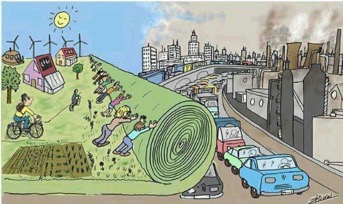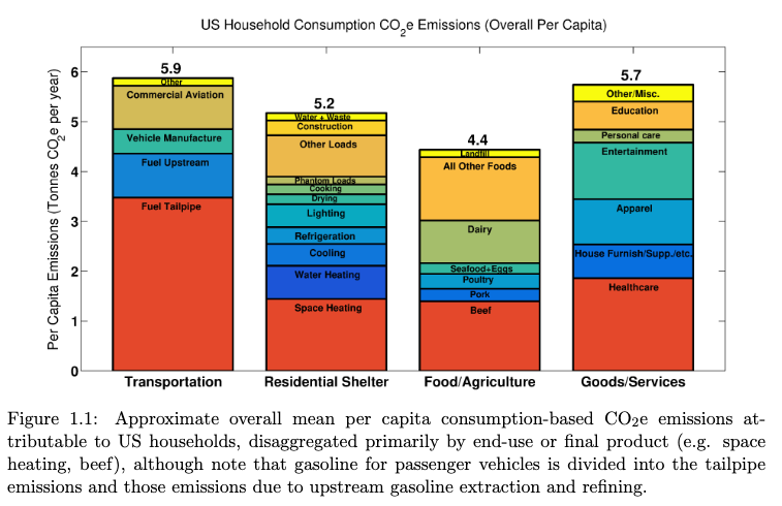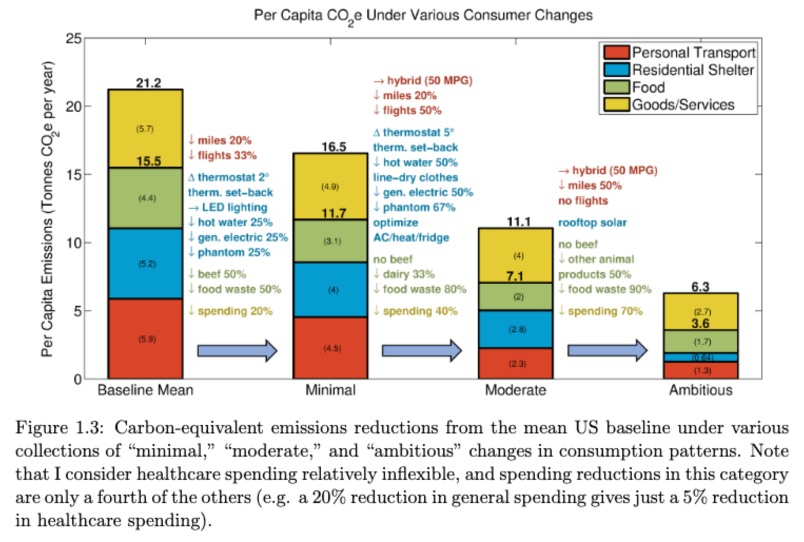![]()
by Hannah Back
1.5°C Lifestyles
In the previous post, I discussed where carbon dioxide (the primary greenhouse gas causing climate change) is coming from. We learned that 85% of US emissions come from households.
Is there anything we can do to reduce our fossil fuel use, on a household level?

Greener lifestyles could be key in fighting climate change.
Some climate scientists believe we can save immense amounts of carbon through “behavioral mitigation”, by just making lifestyle changes1. There is an idea of a “1.5 degree lifestyle”, which is a hypothetical lifestyle that is compatible with limiting warming to 1.5 degrees Celsius (the estimated level of warming that will limit critical effects)2.
Reducing our consumption could help us avoid the worst of global warming. Consumers would have to make different choices, and government policies could help support those lifestyle changes (including promoting things like public transit)3.
How much do we have to change?
Let’s look at the numbers. Each American household causes about 21.2 tonnes (t) of carbon dioxide emissions per year.
That breaks down into different categories of consumption: Transportation, residential shelter, food, and good/services4.

These larger categories are broken down further. For example, most of “transportation emissions” are driven by car’s tailpipe emissions (driving directly releases greenhouse gases as fuel is burned). In our homes, a large amount of the carbon emissions is from heating and cooling. For food related emissions, beef and dairy have a large impact.
One scientist estimated the “carbon savings” from different lifestyle changes. He quantified the impact from different levels of lifestyle change, from “minimal”, to “moderate” and “ambitious” changes4.

He found that even “minimal changes” could have a huge impact! Minimal changes included driving and flying less, raising or lowering thermostat, switching to LED lights, reducing hot water use and spending less money on products that cost carbon to manufacture and transport.
Reducing household electrical use can save 1.2 tonnes of CO2e per year.
In the “minimal changes”, one change people would have to make is reducing beef intake by 50%, which may be hard for some to swallow. Beef has a particularly high carbon impact because of the land use and feed required to raise cattle.
Driving and flying less can save 1.4 tonnes of CO2e per year.
However, there are other ways to make changes! If someone has difficulty cutting back in one area, they could look at other categories that may be easier for them to reduce. For example, living in a college town, I can cut back my driving to nearly zero because of great public transportation. Others may struggle with lack of transit available.
Some people may be more agreeable to adjusting their thermostat and reducing energy use in the home, or even installing solar panels with the help of federal incentives. Some people may have considered eating less meat before, and to them, this could be an easy change. Some people find it easier to reduce spending. People should look at different areas of their lifestyle and consider what changes they would be most willing to enact.
With small changes, you can save almost 5 tonnes of CO2e per year.
If people are willing to make “moderate” changes, their CO2e impact can be reduced to almost half4.
Towards Greener Lifestyles
First, we should work to educate on the impact of lifestyle choices. Then, people can be empowered to choose what changes work best for them and their family. People’s choices also tend to impact those around them.
Of course, some people may find it difficult to make changes, or unwilling to do so. Despite this, our own choices still matter. Once carbon dioxide is released, it cannot be captured. The best answer we have is to prevent more emissions in the first place.
Every bit counts towards keeping us “in the green” on the carbon budget5 – a budget calculated by scientists to measure how much carbon can still be released while avoiding the most severe effects. Current estimates show only about 100 gigatonnes for an 83% chance of staying under 1.5 degrees Celsius of warming6. So, every bit of carbon we release takes away from this budget.
In conclusion, household consumption drives emissions, which drives climate change. The only way to stop climate change is by stopping emissions. Therefore, the choices you and I make in our daily lives are crucial in the battle against climate change.
Don’t let perfect be the enemy of the good—Make what changes you can and encourage those around you!
References
[1] R. Koide, M. Lettenmeier, L. Akenji, V. Toivio, A. Amellina, A. Khodke, A. Watabe, S. Kojima, Lifestyle carbon footprints and changes in lifestyles to limit global warming to 1.5 °C, and ways forward for related research, Sustain Sci 16 (2021) 2087–2099. https://doi.org/10.1007/s11625-021-01018-6.
[2] IPCC, 2018: Global warming of 1.5°C. An IPCC Special Report on the impacts of global warming of 1.5°C above pre-industrial levels and related global greenhouse gas emission pathways, in the context of strengthening the global response to the threat of climate change, sustainable development, and efforts to eradicate poverty [V. Masson-Delmotte, P. Zhai, H. O. Pörtner, D. Roberts, J. Skea, P.R. Shukla, A. Pirani, W. Moufouma-Okia, C. Péan, R. Pidcock, S. Connors, J. B. R. Matthews, Y. Chen, X. Zhou, M. I. Gomis, E. Lonnoy, T. Maycock, M. Tignor, T. Waterfield (eds.)]. In Press.
[3] G. Dubois, B. Sovacool, C. Aall, M. Nilsson, C. Barbier, A. Herrmann, S. Bruyère, C. Andersson, B. Skold, F. Nadaud, F. Dorner, K.R. Moberg, J.P. Ceron, H. Fischer, D. Amelung, M. Baltruszewicz, J. Fischer, F. Benevise, V.R. Louis, R. Sauerborn, It starts at home? Climate policies targeting household consumption and behavioral decisions are key to low-carbon futures, Energy Research & Social Science 52 (2019) 144–158. https://doi.org/10.1016/j.erss.2019.02.001.
[4] S.E. Eikenberry, A fair share: doing the math on individual consumption and global warming, 2018.
[5] Carbon budget, Wikipedia (2024). https://en.wikipedia.org/w/index.php?title=Carbon_budget&oldid=1216099389.
[6] climatechangetracker.org, Current Remaining Carbon Budget and Trajectory: Insights, Data, Charts. 2024. https://climatechangetracker.org/igcc/current-remaining-carbon-budget-and-trajectory-till-exhaustion.